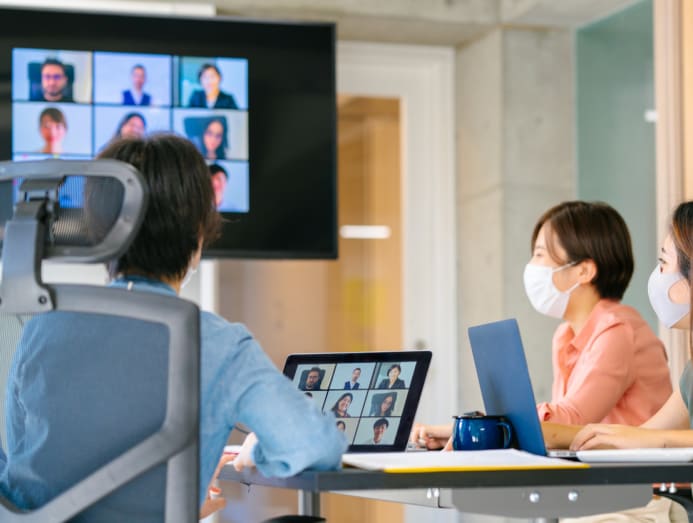Commentary: Don’t make employees return to the office to make Zoom calls
After two years of working apart, companies need to give workers a good reason to be physically in the office and not just perform tasks they could do at home, says EngageRocket’s Leong Chee Tung.

SINGAPORE: Tesla CEO Elon Musk expects employees to return to the office or leave, according to a company memo reported on Wednesday (Jun 1).
Tesla’s move has created a stir, as companies worldwide reopen their doors to employees after over two years of working from home. Are Musk’s expectations shared unsaid by other employers? Have employees not earned some flexibility by proving their productivity during the pandemic?
Companies argue that working together in a shared physical space is essential for team building and collaboration, with some pushing for full-time work-from-office (WFO) or a hybrid model with a certain number of days in the office.
Google’s ex-HR chief Laszlo Bock told Bloomberg that large companies like his former company want workers back in the office, claiming that one Google executive told him: “We’ll get everyone back into the office eventually. I just don’t want to pick that fight now.”
Employees may be less enthusiastic – leading to a significant disconnect. A majority of Singapore workers prefer flexible work arrangements, instead of working from either home or office on most days of the week, according to a study by the Institute of Policy Studies.
This means that, when executed incorrectly, RTO plans cause more harm than good. A US study found that half of the workers would rather quit than return to the office full-time, exacerbating the already challenging effects of the Great Resignation. Even if workers don’t leave, they may end up feeling more disengaged than ever.
But there are ways to overcome this disconnect without alienating employees or sacrificing the benefits of the workplace.
HUGE GAMBLE TO INSIST ON WORKING IN THE OFFICE
At the outset, employers should accept that full-time WFO may be a thing of the past for a majority of workers, especially those in knowledge management or desk-based roles.
Employees are almost always opposed to full-time WFO, but hybrid work is seen differently. While they like the flexibility and not spending time on the daily commute, employees also realise and recognise the benefits of on-site working – less time spent on digital collaboration platforms, more constructive feedback and stronger connections with co-workers.
Research finds that collaboration and socialising are the top reasons why employees want to go to a physical workplace, ahead of reasons like better focus without home distractions, workplace perks and career advancement.
So like it or not, hybrid work arrangements can satisfy both employee sentiment and company objectives. Insisting otherwise will be a huge gamble.
What employers have to first ask themselves while making RTO plans is: “What is the reason for bringing employees back to the office?”
Do they want people in cubicles or engaged, productive workers who deliver results? If someone is already productive, is there a real need to lift and shift them to a different setting, and impose challenges like commute time and costs?
The answers to these questions are often apparent to business leaders and senior executives, but not communicated very well to employees on the ground.

THE NEW WORK-FROM-OFFICE EXPERIENCE
Employers need to rethink how the physical aspect of work adds value to an employee. If companies believe face-to-face interaction is essential for team cohesion, creative collaboration and serendipitous opportunities, they need to show it is more than just lip service.
Employees do not want to go into the office just to take endless Zoom calls, sit in isolated cubicles, eat lunch on their own and not engage in any informal discussions.
Companies must prevent the office from replicating the negative aspects of working from home. After all, 56 per cent of employees report experiencing burnout during the pandemic and mental health became worse for many employees.
Not only can collaboration and socialising drive productivity but also alleviate the mental health burden arising from continued isolation.
Instead of transplanting work from home into the office, organisations and teams should think of curating the office experience. These can be collaboration days, team lunches, in-office events or even face-to-face happy hours – purposefully creating opportunities for meaningful professional and social interaction is the way to go.
According to a survey by Envoy, 88 per cent of companies use incentives to motivate employees to return to the office. Out of those, the top five incentives are food and beverage programs, social events, company events, furniture and amenities and office environment.
And these intentions and expectations should be clearly communicated when outlining and executing an RTO program.
For example, CGS-CIMB fine-tuned their policies to ensure collaboration and productivity while maintaining flexible working arrangements. In planning for their new office space at Marina Bay Financial Tower 2, the financial services firm took into account a long-term vision of a post-pandemic future.
They engineered a physical office experience around human connection, such as a co-working space designed to incorporate an office setup with recreational amenities that include a jukebox and beer tap. Newly implemented practices, such as monthly staff happy hour and team building events, in the right doses can motivate people to want to go back to the office - not just to work, but to reconnect with others.
EMPLOYERS STILL NEED TO TAKE REMOTE WORK SERIOUSLY
In a hybrid arrangement, workers will be away from the office several times a week. Besides improving the office experience, companies need to keep up with remote employee engagement and initiatives that prioritise their well-being. Those who have managed to do this well have seen engagement rise and productivity improve.
For example, tech firm Sabre announced a series of new employee benefits following the success of its “work from anywhere” policy. The company announced that employees could gain access to a wellness app, take paid time off to volunteer, gain mentoring support and participate in interest groups.
Taking care of employees while they work from home can also make them feel better about being called back into the office. Spending on employee engagement and well-being initiatives shows that employers are serious about investing in remote work.
But a hybrid work arrangement is not a static one. Finding the right balance between home and office will always require continued engagement and refining. Employers may want to collect employee feedback on the experience they wish to have at the office and ideas on how to improve collaboration and productivity.

EMPOWERING MANAGERS TO DRIVE CHANGE
The job of implementing workplace change tends to fall on the shoulders of team leaders and middle management.
Unfortunately, they are not always equipped to do so. During the pandemic, 66 per cent of employees did not feel comfortable talking about mental health with their manager, which could be due partly to shortcomings in training and communication channels.
On top of that, managers do not always have access to the information they need to implement changes in their teams and mitigate the negative sentiments towards RTO. Managers need to be empowered so they can be more confident in making decisions that are best for the team and the business.
In a recent EngageRocket study of HR professionals in the Asia-Pacific region, 42 per cent find it difficult to include managers in the process to take action on employee feedback. This is not due to a lack of will, but rather owing to a lack of clarity on what and how actions need to be taken.
A successful RTO program will need empowered managers. Managers can benefit from guidance on how their teams can collaborate effectively in person, with exact action points on employee morale, productivity and well-being challenges.
Ultimately, hybrid work is here to stay. Employers must give employees both a tangible reason to want to be in the office and support to work at home. Hybrid employees can enjoy the best of both worlds, but so can employers.
Chee Tung Leong is the co-founder of EngageRocket, a people analytics provider.








